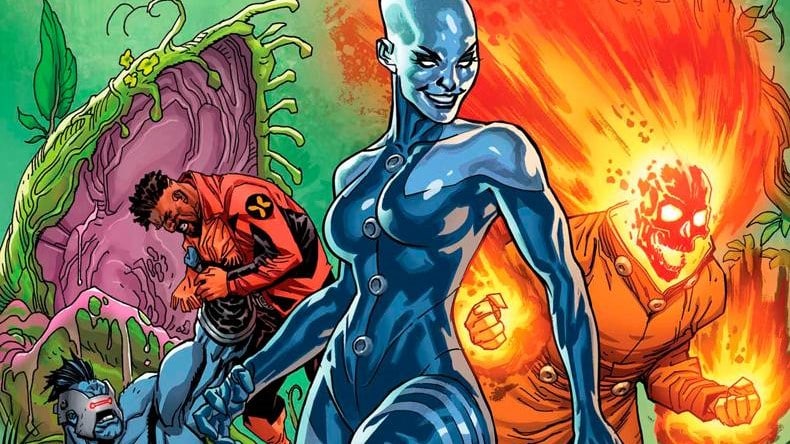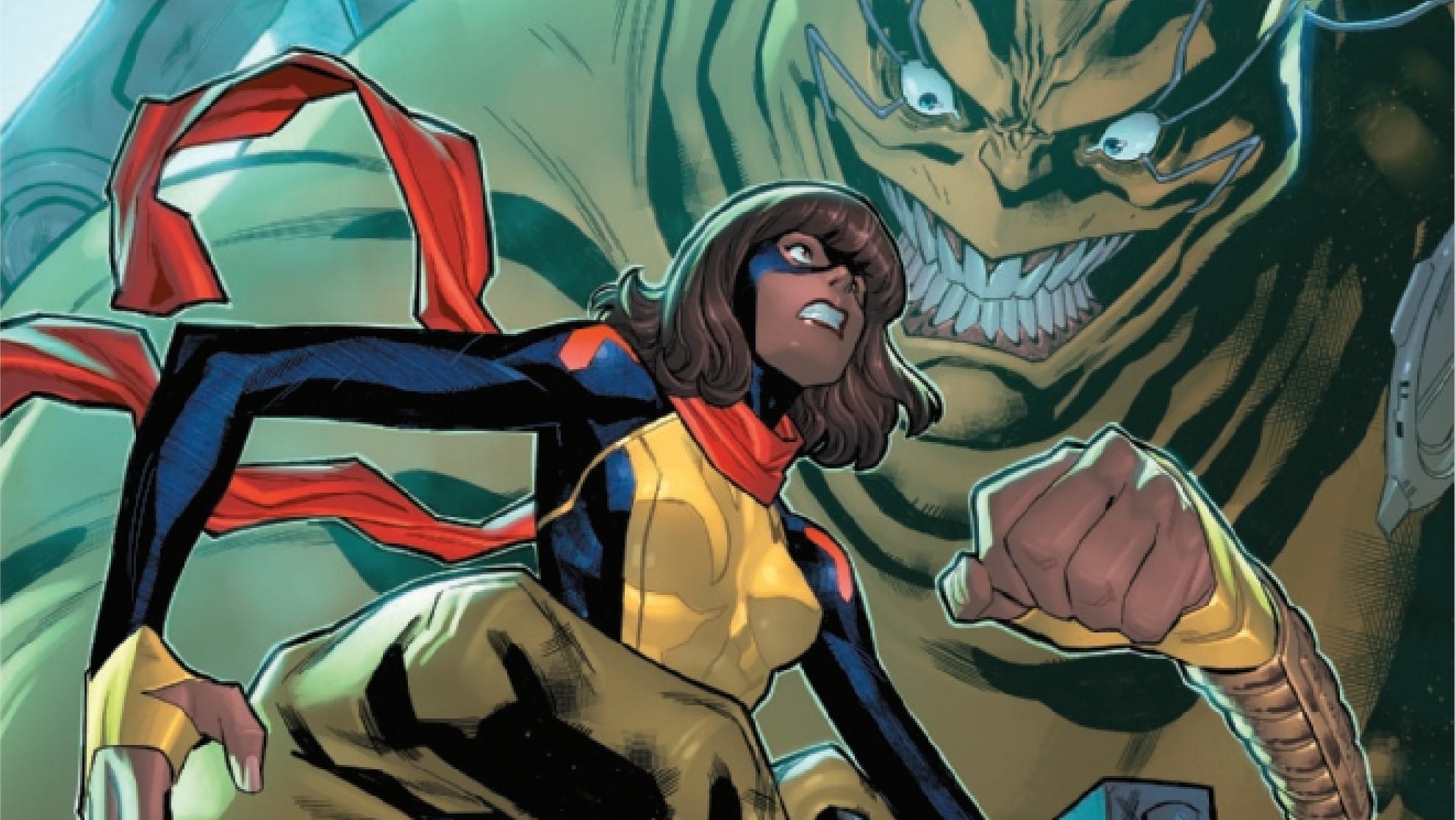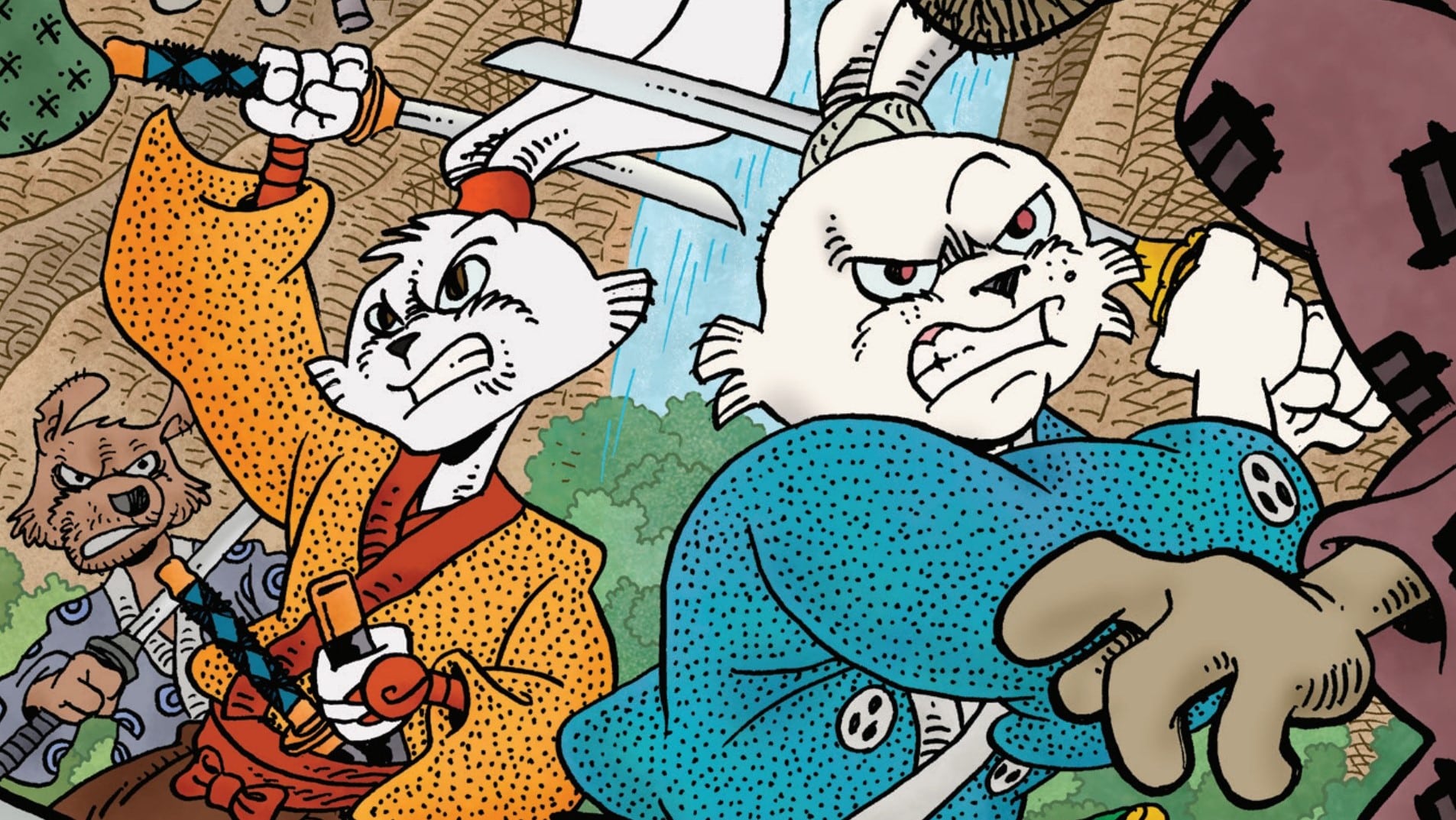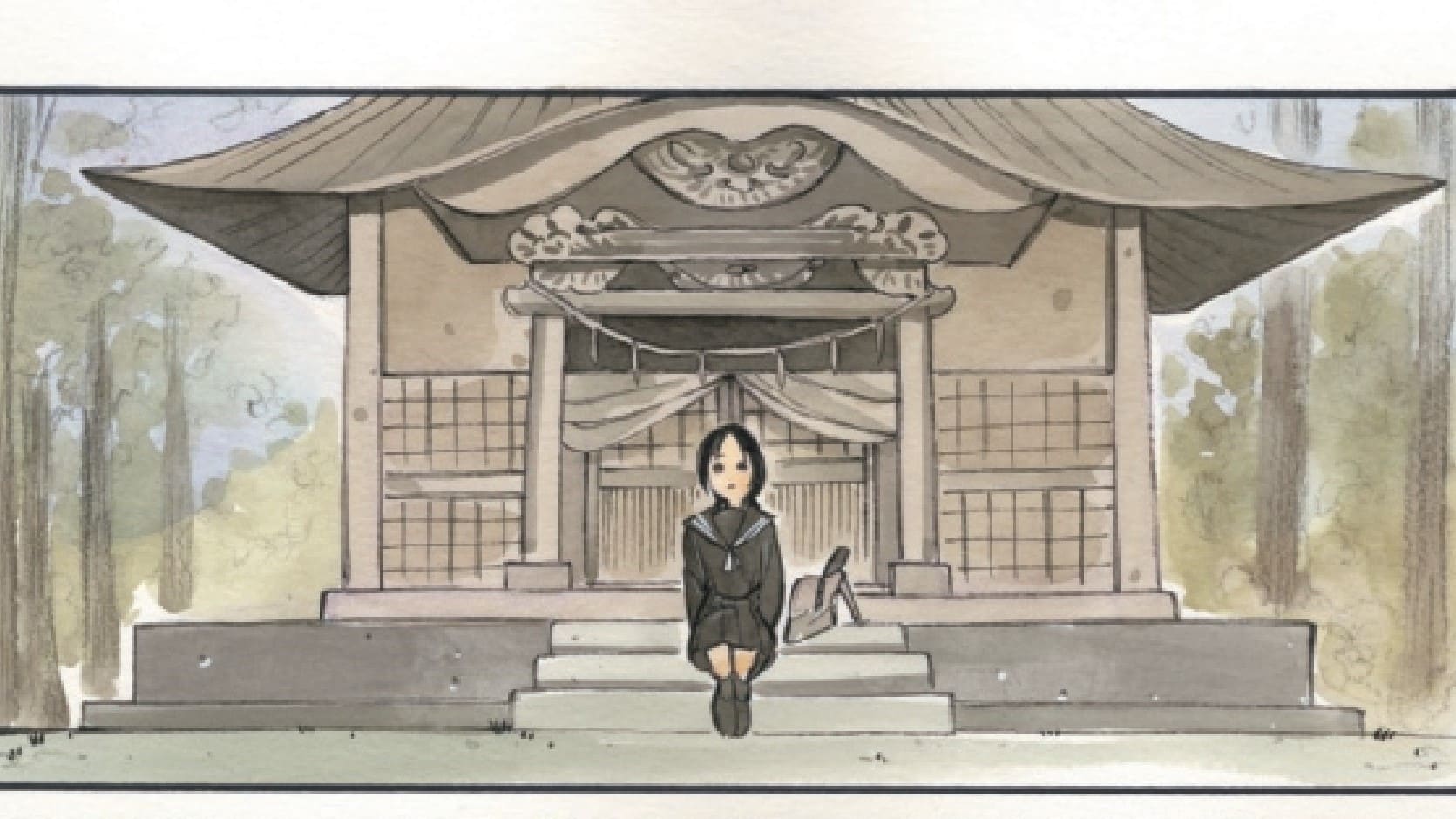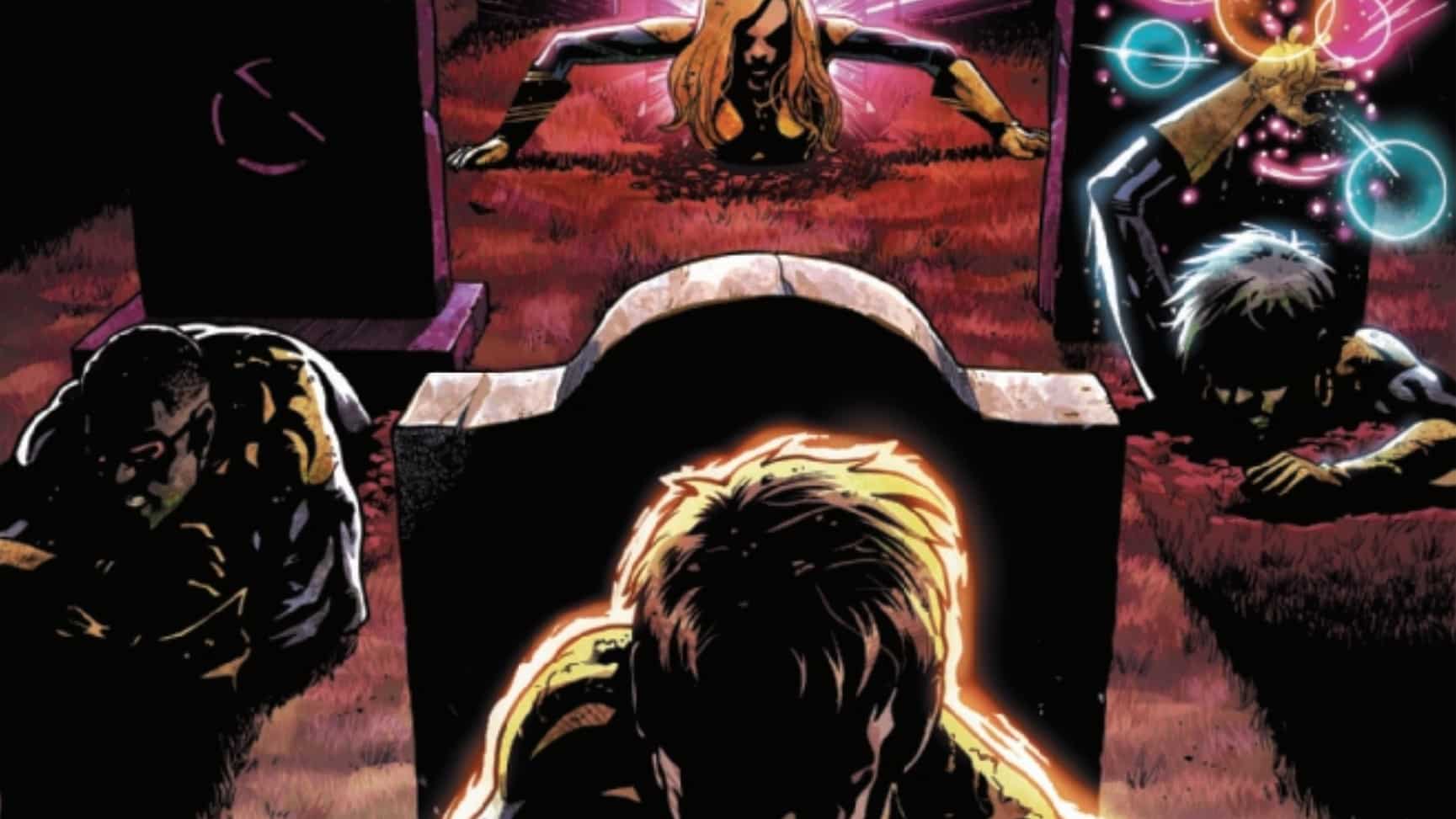Sealed in a dream-state by Krakoan technology, the fearsomely powerful Children of the Vault have been dormant in Chile while thinking they’ve taken over the world. Now Krakoa belongs to the past. Are the Children the future? Not if Cable and Bishop have much to say about it in Children of the Vault #1, written by Deniz Camp, drawn by Luca Maresca, colors by Carlos Lopez, letters by VC’s Cory Petit.
Ian Gregory: I’m pretty excited for this one. My first review gig was covering Duggan & Noto’s Cable with Ritesh Babu, and you and I just got done covering Marauders, and this book features (a) Marauder. It would take a lot less than “Bishop and Cable: Buddy Cops” to interest me in a book.
Stephanie Burt: Glad to be back with you, buddy. It would take more than that to hook me in — there’s strong power-bro fantasy vibes, or maybe bro-power-fantasy vibes, along with some last-man-on-earth undertones, to the Bishop-and-Cable part of this story. But but but! There’s also some neat science fiction. The Children of the Vault — first seen in adjectiveless X-Men #188, first drawn by the peerless Chris Bachalo — are hyper-evolved future mutants who truly believe they’re bound to save the rest of humanity and bring a better tomorrow, no matter how much of today they burn down. They’re like tankies with mind control powers. But way more fun. I’m always up for stories about them, and how to stop them. If they can be stopped.
Save the World

Ian: We start off with the titular Children of the Vault waking from the bio-dome they were placed in back in X-Men #15. Rather than attempt to kill the super-evolved Children, Forge put them into a dreamstate where they could imagine their perfect victory, never knowing they were trapped in a prison to begin with. Now that Krakoa itself is gone in the wake of the Hellfire Gala, Forge’s prison fails. Is it too nitpicky to say this is some just plain old bad engineering on Forge’s part? What kind of mutant doesn’t plan for the abrupt disappearance of their home?
Stephanie: We can No-Prize this one! the machine — which also had biological, plant-based components, Krakoa-related foliage — required a great deal of energy to function: energy transmitted, let’s say, through the Krakoan root system that powered the gates. With the gates down or transformed, the plant-based system fails. “Chloroplastic cell clusters self-immolate,” says the prose, “and vital root systems wither.” With all those time stamps, writer Deniz Camp’s paying homage to Ray Bradbury’s “There Will Come Soft Rains,” a story that X-fans should probably know.
Ian: From there, the Children enact a plan much more sophisticated than their previous attempts at “kill anyone and everyone in our way.” They rebrand as the Children of Tomorrow, become superheroes, and quickly pick up a large following (as in, within the span of a month). The Children are now the Earth’s most popular superheroes. I get shades of the original Thunderbolts from this; it’s certainly not the first time that villains have had the idea to pose as superheroes to gain the public’s trust.
Stephanie: Agreed. But do they even think they’re villains? I thought the Children always believed that they’d save humanity. Granted they have to destroy a lot of humanity to do it. And they’ve had who knows how many generations, in the Vault’s sped-up chronology, to make plans, or they did before Forge trapped them in that dream state. (Waves hands in the air). Luca Maresca draws these guys beautifully. They look shiny and new and like they come from the far future.
Ian: The Children have, I think, always been defined by their visual dynamism. Maresca is doing a good job carrying that tradition forward. Maybe they want to kill all humans, maybe they’re good guys, but they always look cool while doing it.
Also, there’s a sequence in the lithium fields after we see the Children wake up, but before we get the exposition on what they’ve been up to. The timing on it is frustratingly ambiguous — it seems to me to take place after the Children have arrived (“a few weeks later” from when they woke up), but we just don’t know enough to place when this is. Anyway, a young boy commits suicide by drinking lithium and posing with a picture of a futuristic city in the background (“The City?”), saying that the future has failed him. Something about these pages felt off to me.
Stephanie: IDK, the lithium mining ponds in the Chilean desert, and the eco-catastrophe they create, are real things and I like that Deniz Camp wants us to know about them. Chile appears to be nationalizing its lithium industry, which is maybe a good thing? There’s something going on with the Children of the Vault and political allegory. But I’m not sure how it works yet. Or whether it does. And again, Luca Maresca’s terrific: I like that enormous city descending on the poor Chilean kid as he holds up his cell phone. It’s not even a white savior, since the Children are mostly not white!
Ian: I don’t really object to the inclusion of the lithium pools — a serious issue that those of us in the USA get to conveniently ignore — so much as being uncertain about where it will come into play in this series.
Overall, while it’s not the most original premise, I do like that it creates a situation in which both Cable and Bishop shine: as underdogs fighting against a popular, evil establishment. Cable spent his whole life training against Apocalypse for basically just this situation. Speaking of Cable, let’s talk about our two heroes.
Running with Our Eyes Closed

Ian: Orchis captures Cable, but they quickly learn that having him and getting him to do what they want are two very different things. I have to be up front about this: I’m a huge mark for Cable. He’s my large adult son. I will always enjoy a book which shows him some respect, and he gets a lot of that here. He meditates his way through a sequence of torture and interrogation techniques, and has plans to escape his inescapable prison in a few days. This escape is interrupted by his unlikely savior, Bishop. Have you read the Swierczynski Cable series, Stephanie?
Stephanie: I just started reading it. On your recommendation. There are cockroach-human hybrids, Cable is married to someone named Hope who looks just like Hope, and of course Bishop keeps on trying to kill them…
Ian: Later on, the narration refers to Cable and Bishop’s beef as being the result of a “misunderstanding,” which I thought was a hilarious understatement [Ed. Note: To say the least]. But suffice to say that these two haven’t seen eye-to-eye since 2008. As a result, it creates an enjoyable tension between the two of them. Bishop is the rescuer, but Cable is the one who has planned for this exact situation. I like the way these two bounce off each other, and I like that this story puts them in a situation that feels natural for both characters.
Stephanie: You’re not wrong, but they’re also both tough dudes who’ve been through a lot, and writing them means showing just how tough and dudely they are and how they’ve been shaped by the wars they’ve been through. Usually buddy cop movies have a tough guy and a comedian, or a fish out of water. Who’s the comedian? Who’s the fish? Where’s the water? How different are they, really? Except that Cable has cooler powers. And, at the moment, fewer arms.
Ian: Cable is also using his full mutant powers in this series (high-level telepathy and telekinesis), a rarity for him. Most of the time, Cable is stuck using his mutant powers to keep his TO Virus in check, but that’s not an issue for him here. I think the last time we saw Cable do much more than shoot a couple of TK bolts around was Cable & Deadpool, from 2004-ish. He’s also pretty brutal with the mind control here, convincing an entire Orchis hit squad that they’re secretly mutant defectors, leading to one’s eventual death by failed-mutant-flight.
Stephanie: I did not see this tactic coming, and I like it. Why doesn’t Cable use it more often? Also, can we give props to Camp and Maresca for depicting Cable almost naked, because he just doesn’t have time to grab any clothes? A less courageous artist would put Nathan Dayspring Askani Christopher Summers into a bathrobe. Or pajama pants.
Ian: I wish he did use it, and all his powers, more often. It doesn’t help that Cable basically doesn’t use any mutant powers for a couple dozen issues when he first appears, and only much later are they actually defined. I think that, in a meta-sense, he has so many more stories where he never uses his powers than ones where he does, that writers rarely depict him doing anything much more complicated than a force push. It’s nice to see him use his powers in a more engaging and interesting way, and one that reveals his general lack of regard for lives, boundaries, or any of that silliness.
Cable and Bishop are both characters who will go to extreme lengths to achieve their goals. After all, Bishop once killed several billion people just to get at Cable [Ed. Note: See? Understatement]. They’re two characters with similar outlooks and methodologies, but who are completely opposed on a personal level. The advantage of this setup is that it keeps the plot moving (as they both logically agree on what must be done) but still creates a lot of opportunities for them to fight and argue (as they hate each other’s guts).
Stephanie: The disadvantage is that two characters talk the same way and think the same way and at some point the letterer is likely to mix up their speech balloons. “Works for me.” “It’s just you?” “Yeah…. just me. Now let’s get outta here!”
Ian: I don’t disagree. It’s been a longstanding point that Cable and Bishop are painfully similar in demeanor and character concept. When they’re off in series not interacting with one another, it’s not an issue. I’m hoping that Camp takes this opportunity to highlight some differences between the two.
What’ve I Done to Help

Ian: Once Cable and Bishop have a moment alone inside one of Cable’s doomsday prep hideouts, it is quickly discovered that Bishop has been infected with some kind of mental virus. Using his tattoo suite (I still hate it, reader), Cable diagnoses a growing spot on Bishop’s brain, changing his thinking, and quickly fingers the Children as the culprit. This would explain Bishop’s willingness to give them the benefit of the doubt, as well as the speed at which their message has spread.
Stephanie: It would. Also Bishop’s distracted: his “war journal” shows his plans to travel around the world blowing up or otherwise destroying almost two thousand ORCHIS installations as revenge for Krakoa. He’s in bad shape. “In fire enormous metal vacant faces seemed to scream. Following day slept in basement of abandoned baby-food factory, saw faces in dreams.”
Ian: The virus itself isn’t telepathic, but a combination of a couple of sources. There’s the Hawkspox, which I think is brand new. The Techno-Organic Virus, an old standby. And then there’s Weapon XVI, Allgod from, uhh, Dark Reign: Wolverine. And Hexus the Living Corporation from, uhhh, Marvel Boy??? Wild. Anyway, this immediately reminded me of the Growing City of Orqwith from Morrison’s Doom Patrol, itself based on the Borges story “Tlön, Uqbar, and Orbis Tertius.”
Stephanie: It seems to be, literally, a woke mind-virus. I’m honestly more taken by the way that the Children’s plan appears to solve genuine problems in the global South. I’m sure it’s a fake or a trick of some kind but it looks good, and G-d knows we need something besides global climate summits. How will the trick or the big reveal turn out? Are we at the end of history, like in the 90s? “Everything was better in the 90s,” Cable declares. He sure was a big deal then.
Ian: Someone get Francis Fukuyama on the phone. You’re right that my default assumption is that the Children somehow manufactured all the crises they then saved people from. But I’m really hoping that their aid turns out to be genuine, at least in part. I think it would make for a much more complicated story to have removing the Children be something other than an unmitigated good – and that, in taking them down, Cable and Bishop end up creating even more problems. It would certainly be in character for the both of them.
I think this is a pretty good start to the story. This is a four-issue mini, which is probably the perfect length for a small cast takedown of a single villain. While an “idea virus” isn’t any newer than “villains pretending to be heroes,” I like the way they’re combined to create a serious problem for Bishop and Cable. Both characters excel at picking fights and hunting down single adversaries; just by themselves, they could probably kill the Children. But having to change the mind of all humanity on the Children is a nice twist — especially because Bishop has already been infected.
In all, I was pleasantly surprised by this issue. I think that Cable and Bishop are two characters who naturally fit into a Fall of X-style mood: they’re serious, violent people who are best when their backs are against a wall. A good Cable story relies on a mix of heady sci-fi concepts and pure violence, and I think that Camp and Maresca have got a good start here.
Stephanie: Agreed. Though I’m a lot more interested in the Children than in Cable and Bishop so far. These far-future would-be saviors could become fascinating anti-heroes, or heroes gone wrong, as in the old Squadron Supreme. Or Oankali, who genuinely want to take care of individual human beings but are Just So Done with how humans are ruining the planet, running the Earth itself into the ground.
Children of the Notes
- Orchis decides not to intervene against the Children, I guess because their kanban board is already full.
- Cable’s New York real-estate mogul tendencies are actually a longstanding part of his character — it comes up in Swierczynski’s Cable and in the original X-Force. [Ed. Note: Never forget Cable went to Harvard Law and passed the New York Bar].
- Backwards baseball cap dude to Cable in Manhattan: “I’m a big fan, Mr. Brolin.”
- Cable’s flower shop secret hideout is called “Dayspring.” Fic writers, take note.

